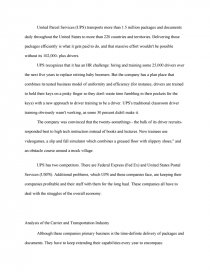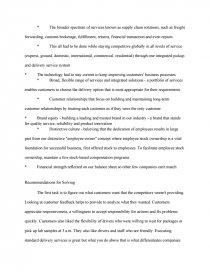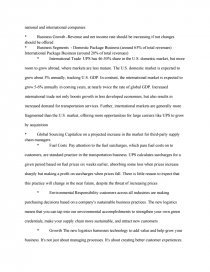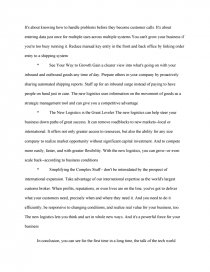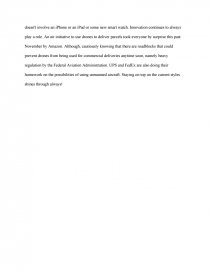Analysis of the Carrier and Transportation Industry
Essay by gibbons323 • December 19, 2013 • Essay • 1,540 Words (7 Pages) • 1,676 Views
Essay Preview: Analysis of the Carrier and Transportation Industry
United Parcel Services (UPS) transports more than 1.5 million packages and documents daily throughout the United States to more than 220 countries and territories. Delivering those packages efficiently is what it gets paid to do, and that massive effort wouldn't be possible without its 102,000- plus drivers.
UPS recognizes that it has an HR challenge: hiring and training some 25,000 drivers over the next five years to replace retiring baby boomers. But the company has a plan place that combines its tested business model of uniformity and efficiency (for instance, drivers are trained to hold their keys on a pinky finger so they don't waste time fumbling in their pockets for the keys) with a new approach to driver training to be a driver. UPS's traditional classroom driver training obviously wasn't working, as some 30 percent didn't make it.
The company was convinced that the twenty-somethings - the bulk of its driver recruits-responded best to high tech instruction instead of books and lectures. Now trainees use videogames, a slip and fall simulator which combines a greased floor with slippery shoes," and an obstacle course around a mock village.
UPS has two competitors. There are Federal Express (Fed Ex) and United States Postal Services (USPS). Additional problems, which UPS and these companies face, are keeping their companies profitable and their staff with them for the long haul. These companies all have to deal with the struggles of the overall economy.
Analysis of the Carrier and Transportation Industry
Although these companies primary business is the time-definite delivery of packages and documents. They have to keep extending their capabilities every year to encompass:
* The broader spectrum of services known as supply chain solutions, such as freight forwarding, customs brokerage, fulfillment, returns, financial transaction and even repairs
* This all had to be done while staying competitive globally in all levels of service (express, ground, domestic, international, commercial, residential) through one integrated pickup and delivery service system
* The technology had to stay current to keep improving customers' business processes
* Broad, flexible range of services and integrated solutions - a portfolio of services enables customers to choose the delivery option that is most appropriate for their requirements
* Customer relationships that focus on building and maintaining long-term customer relationships by treating each customer as if they were the only customer
* Brand equity - building a leading and trusted brand in our industry - a brand that stands for quality service, reliability and product innovation
* Distinctive culture - believing that the dedication of employees results in large part from our distinctive "employee-owner" concept where employee stock ownership is a vital foundation for successful business, first offered stock to employees. To facilitate employee stock ownership, maintain a few stock-based compensation programs
* Financial strength reflected on our balance sheet so other few companies can't match
Recommendations for Solving
The first task is to figure out what customers want that the competitors weren't providing. Looking at customer feedback helps to provide to analyze what they wanted. Customers appreciate responsiveness, a willingness to accept responsibility for actions and fix problems quickly. Customers also liked the flexibility of drivers who were willing to wait for packages or pick up lab samples at 3 a.m. They also like drivers and staff who are friendly. Executing standard delivery services is great but what you do above that is what differentiates companies.
The challenge remains how to replicate the behavior and scale it across the company. This is where company culture became an issue. Most companies have a loyalty-based culture that placed a lot of value on longevity rather than contribution. Most of the employees who had been there longer did have as much compliments as the newer employees. To solve that issue, companies should move from a loyalty-based system to a merit-based system and make a leadership manifesto led by corporate culture specialists, Logistyle, reinforced the behavior you wanted. For example, stress and praise those who are willing to try even if they fail. Also that kindness should never be confused with weakness, and that people should be encouraged to take risks and shake up the status quo.
Changing behavior at any company can be a challenge and is often met with resistance. Sticking to a vision of rewarding people not for their length of service but for furthering the brand by doing the things customers wanted and needed. Giving raises based on how much employees contribute can help to start a company-wide sales lead program that should be particularly attractive to drivers. Those who bring in warm leads that convert to shipments get 10 percent of the resulting revenue for a year. So a driver who is astute and engaging can literally double,
...
...
